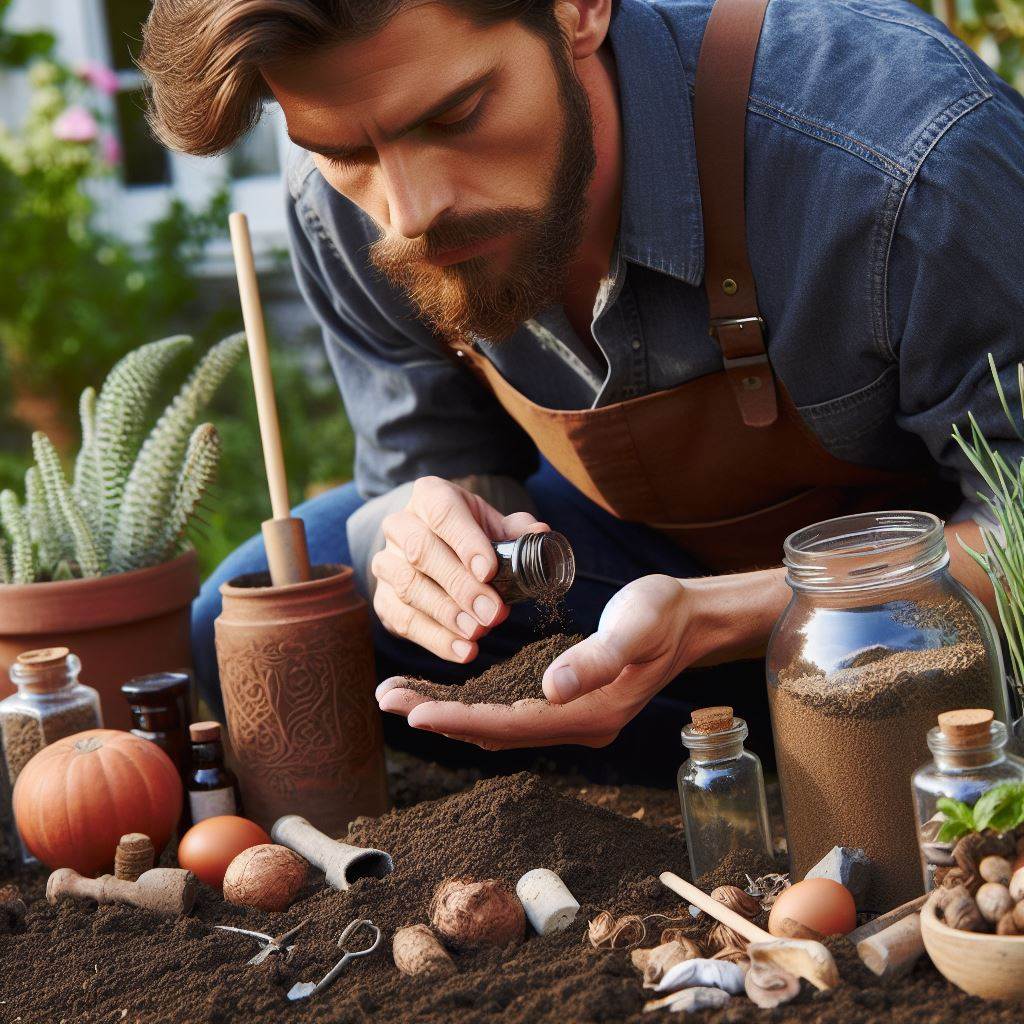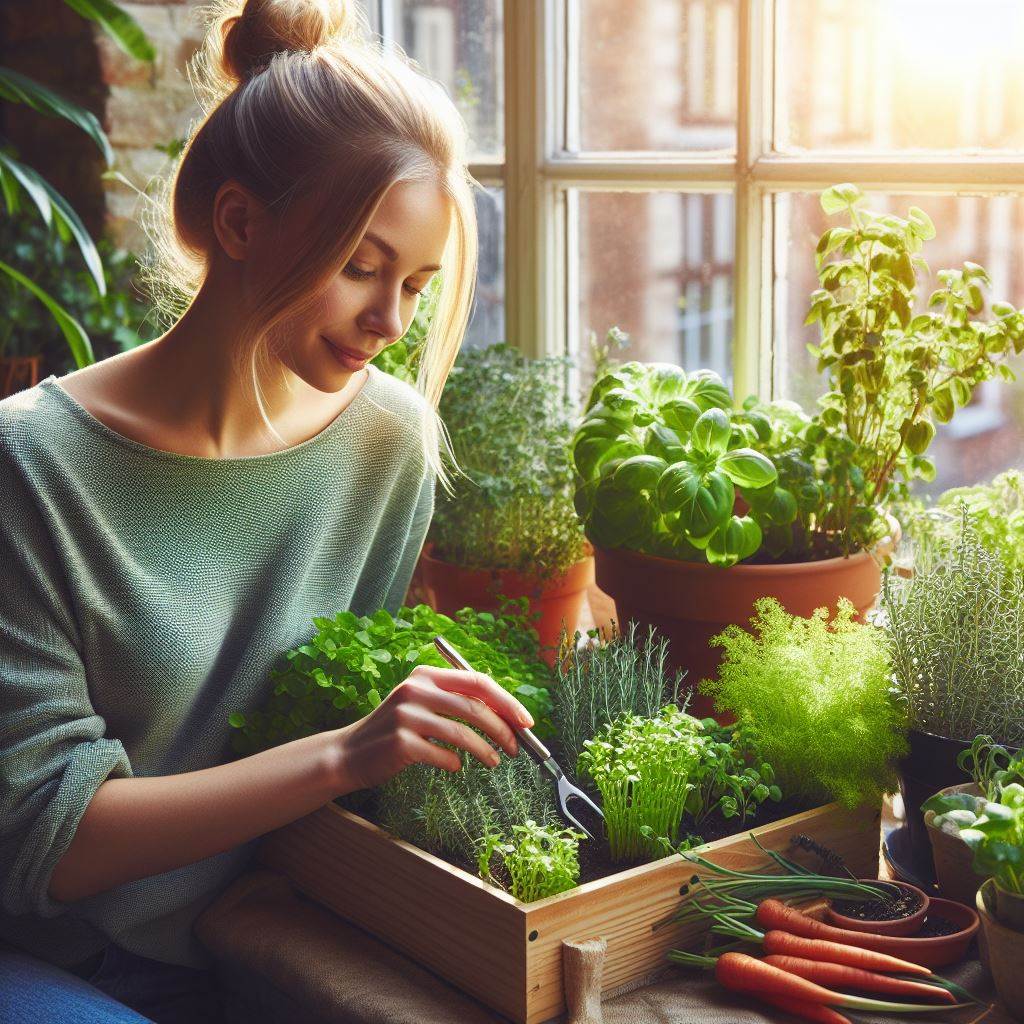Introduction
A. Definition of efficient herb gardening in mini plots
Efficient herb gardening in mini plots refers to maximizing productivity in small garden spaces by carefully planning and organizing the layout.
It involves utilizing limited areas effectively to grow a variety of herbs.
B. Importance of efficient herb gardening in limited spaces
Efficient herb gardening in mini plots is crucial for urban dwellers who have limited gardening spaces.
It allows them to enjoy the benefits of fresh herbs even with limited area availability.
Furthermore, efficient herb gardening in mini plots is essential for those who want to save money on grocery bills by growing their own herbs.
It also enables individuals to have access to fresh and high-quality herbs all year round.
Additionally, it promotes sustainability as it reduces the reliance on store-bought herbs, which are often packaged in plastic. Efficient herb gardening in mini plots also offers numerous health benefits.
The act of gardening itself can be therapeutic and reduce stress levels. Freshly harvested herbs are more nutritious, flavorful, and free from harmful pesticides.
Moreover, having a herb garden at home encourages individuals to incorporate herbs in their daily cooking, leading to a healthier diet overall.
Therefore, efficient herb gardening in mini plots is a practical and rewarding approach for maximizing productivity and enjoyment from limited garden spaces.
Choosing the Right Herbs for Mini Plots
When it comes to efficient herb gardening in mini plots, choosing the right herbs is crucial.
Here are some factors to consider:
- Selecting herbs that are suitable for small spaces: Opt for smaller varieties such as dwarf basil, chives, or thyme that don’t take up much space.
- Considering the climatic conditions and sunlight availability: Take into account the weather conditions and sunlight your mini plot receives. Different herbs have different preferences.
- Choosing herbs with compact growth habits: To maximize limited space, look for herbs that have a compact growth habit, such as oregano or dill.
- Making use of vertical space: Utilize hanging baskets or a trellis to grow herbs like thyme or climbing rosemary.
- Prioritizing multi-purpose herbs: Select herbs like lemon balm that can be used for both culinary purposes and as an insect repellent.
- Considering companion planting: Plant herbs like basil and chamomile that benefit the growth of neighboring plants and repel pests.
- Being mindful of perennial herbs: Include perennial herbs like mint, thyme, and oregano for consistent harvests year after year.
- Researching growth habits and maintenance requirements: Before selecting herbs, research their specific needs to ensure proper care.
- Considering aesthetic appeal: Choose herbs that complement the overall look and feel of your mini plot.
- Experimenting with different herbs: Don’t be afraid to try out new herbs to discover unique flavors and aromas.
Efficient herb gardening in mini plots requires careful consideration of the right herbs.
By selecting suitable varieties, taking into account climatic conditions, and utilizing space effectively, you can create a thriving herb garden in a limited area.
Read: Herb Boxes for Beginners: Small Space Edition
Transform Your Agribusiness
Unlock your farm's potential with expert advice tailored to your needs. Get actionable steps that drive real results.
Get StartedDesigning the Mini Plot
A. Evaluating the available space for gardening
- Measure your available space: Before starting your mini herb garden, it’s essential to measure the area you have.
This will help you determine how many herbs you can grow and plan accordingly. - Consider sunlight and shade: Assess the amount of sunlight the area receives throughout the day.
Most herbs require at least 6 hours of sunlight to thrive. Plan your layout accordingly, placing sun-loving herbs in the sunniest spots. - Assess soil quality: Evaluate the soil in your mini plot. Good soil is crucial for the healthy growth of herbs.
Ensure it is well-draining and rich in nutrients. If needed, consider amending the soil to improve its quality.
B. Planning the layout and arrangement of herbs
- Group herbs by their needs: Herbs have varying water and sunlight requirements.
Group together herbs with similar needs to ensure efficient care and easy maintenance. This will also make it easier for you to water them accurately. - Consider height and width: Take into account the mature size of each herb when planning their placement.
Taller herbs should be situated towards the back or center, while shorter ones can be placed in front or along the edges. - Companion planting: Utilize companion planting techniques to maximize growth and repel pests naturally.
Some herb combinations, such as basil and tomatoes, can benefit each other when planted together.
C. Utilizing vertical gardening techniques for maximizing space
- Install hanging planters: Hang planters from railings, walls, or overhead structures to grow trailing herbs like thyme or trailing rosemary. This allows you to use vertical space effectively, especially in small areas.
- Build vertical herb walls: Construct a vertical herb wall using wooden pallets or repurposed materials. Plant herbs in the nooks and crannies, creating a stunning and space-saving green wall.
- Utilize trellises: Train climbing herbs like mint or vining plants such as cucumbers to grow on trellises. This saves horizontal space while adding an aesthetically pleasing element to your mini plot.
- Utilize tiered shelving: Invest in tiered shelving units specifically designed for small gardens. These allow you to grow multiple herbs in a compact space, with each tier accommodating different varieties.
- Hanging baskets: Suspend herb-filled hanging baskets from hooks or sturdy branches. This not only saves space but also adds a decorative touch to your mini plot.
Most importantly, efficient herb gardening in mini plots requires careful consideration of available space, proper layout planning, and the utilization of vertical gardening techniques.
By evaluating the space, planning the layout strategically, and using vertical gardening tools, you can create a thriving mini herb garden that maximizes every inch of space.
Happy gardening!
Read: Apartment Herb Gardening: Freshness on Hand
Soil Preparation and Container Selection
When it comes to efficient herb gardening in mini plots, soil preparation and container selection are key factors that can make or break your success.
In this section, we will delve into the importance of good quality soil, amending the soil with organic matter and nutrients, and selecting appropriate containers for your mini herb plots.
A. Understanding the importance of good quality soil
- Good quality soil is the foundation of a thriving herb garden.
- It provides essential nutrients, adequate drainage, and proper aeration for the plants.
- Poor quality soil can lead to stunted growth, low yield, and increased susceptibility to diseases.
- Conduct a soil test to determine the pH level and nutrient deficiencies in your mini plot.
- Based on the test results, amend the soil accordingly to create a favorable growing environment for your herbs.
B. Amending the soil with organic matter and nutrients
- Organic matter, such as compost or well-rotted manure, improves soil structure and fertility.
- Add a generous amount of organic matter to your mini plots before planting the herbs.
- It helps retain moisture, promotes root development, and releases nutrients gradually.
- Supplement the organic matter with additional nutrients like bone meal or organic fertilizer.
- Follow the recommended dosage and application instructions for the specific herbs you are growing.
C. Selecting appropriate containers for mini herb plots
- Choose containers that are suitable for the size and growth habit of your herbs.
- Pots or containers should have adequate drainage holes to prevent waterlogging.
- Consider the material of the container, such as clay, plastic, or wood, based on your preferences and the herbs’ needs.
- If using recycled or repurposed containers, ensure they are clean and free from any toxins or residues.
- Ensure the containers are deep enough to accommodate the root system and provide room for growth.
In essence, efficient herb gardening in mini plots requires proper soil preparation and container selection.
Good quality soil provides the necessary nutrients for healthy plant growth, while amending it with organic matter and nutrients enhances soil fertility.
Choosing appropriate containers ensures the plants have enough space and proper drainage.
By following these guidelines, you can create a thriving mini herb garden that yields a bountiful harvest.
Read: Compact Herb Gardening: A Step-by-Step Guide
Watering Techniques and Maintenance
A. Establishing a watering schedule
- Determine the watering needs of each herb by considering their specific requirements.
- Plan a watering schedule based on the herbs’ preferences and environmental conditions.
- Take into account the type of soil and its ability to retain moisture.
B. Implementing efficient watering techniques to avoid wastage
- Use a soaker hose or drip irrigation system to deliver water directly to the plants’ roots.
- Mulch the soil with organic materials like straw or wood chips to retain moisture and prevent evaporation.
- Consider using rainwater collection systems or installing a water-efficient irrigation system to minimize water usage.
C. Monitoring and maintaining proper moisture levels in the soil
- Regularly check the soil’s moisture level by using a moisture meter or simply by touching the soil.
- Water the herbs only when the soil feels dry to the touch.
- Avoid over-watering as it can lead to root rot and other plant diseases.
- Adjust the watering schedule as the seasons change, considering factors like rainfall and temperature variations.
- Inspect the plants for signs of nutrient deficiencies or water stress, such as wilting or yellowing leaves.
D. Maintenance tips for efficient herb gardening
- Remove weeds regularly to prevent them from competing for water and nutrients with the herbs.
- Prune the herbs to promote healthy growth and improve air circulation around the plants.
- Remove dead or damaged plant parts to prevent the spread of diseases.
- Monitor for any signs of pests or diseases and take appropriate measures to control them.
- Regularly replenish mulch to maintain moisture levels and prevent weed growth.
- Fertilize the herbs sparingly and using organic options to avoid salt buildup in the soil.
In essence, efficient watering techniques and proper maintenance are crucial for successful herb gardening in mini plots.
By establishing a watering schedule, implementing efficient techniques, and monitoring moisture levels, you can ensure your herbs thrive.
Additionally, practicing regular maintenance tasks will help keep your plants healthy and prevent problems.
Follow these guidelines, and you’ll enjoy a bountiful herb garden in your mini plots.
Read: Urban Herb Farming: Tips for Your Window Ledge

Pruning and Harvesting
In order to ensure improved growth and productivity of your herbs, it is essential to regularly prune them.
By utilizing proper techniques for harvesting, you can harvest herbs without causing any damage to the plants.
Furthermore, once you have harvested your herbs, it is important to make effective use of them in the kitchen.
A. Regularly Pruning Herbs for Improved Growth and Productivity
Pruning herbs on a regular basis is crucial for maintaining their health and maximizing their productivity.
By removing dead or yellowing leaves, you allow the plant to focus its energy on new growth.
Additionally, pruning encourages branching and bushier growth, resulting in a more abundant harvest.
When pruning, make sure to use sharp and clean gardening shears.
Cut just above a leaf node, ensuring that you leave enough healthy foliage for photosynthesis.
Showcase Your Farming Business
Publish your professional farming services profile on our blog for a one-time fee of $200 and reach a dedicated audience of farmers and agribusiness owners.
Publish Your ProfileRegular pruning can be done throughout the growing season, but it is especially important after flowering to prevent seed production and promote continuous growth.
B. Proper Techniques for Harvesting Herbs without Damaging the Plants
Harvesting herbs correctly is essential to maintain the health of the plants and ensure a steady supply of fresh herbs.
Here are some proper techniques to follow:
- Harvest in the morning: Pick herbs when their essential oils are at their peak, typically in the morning after the dew has dried. This ensures the best flavor and aroma.
- Choose healthy stems: Select stems that are sturdy and free from any signs of disease or pests.
- Use sharp pruning shears: Cut the stems cleanly, avoiding any tearing or crushing, which can lead to damage and slower regrowth.
- Harvest selectively: Take only a portion of the plant at a time, allowing the remaining foliage to continue growing.
- Regularly remove flowers: Pinch off any flower buds or blooms to prevent the plant from focusing its energy on seed production rather than foliage growth.
C. Utilizing Harvested Herbs Effectively in the Kitchen
After successfully harvesting your herbs, it is important to make the most of their flavors and aromas in the kitchen.
Here are some suggestions on how to utilize your harvest effectively:
- Cooking: Fresh herbs can elevate the flavors of your dishes. Add them towards the end of cooking to preserve their flavors. Common herbs like basil, parsley, and cilantro work well in a variety of recipes.
- Drying: If you have an abundant harvest, consider drying your herbs for future use. Hang small bundles of herbs upside down in a well-ventilated area to dry. Once dried, store them in airtight containers.
- Freezing: Another option is to freeze your herbs. Chop them finely and place them in ice cube trays filled with olive oil or water. Once frozen, transfer the cubes to freezer bags for easy use in soups, stews, and sauces.
- Infusing: Create flavored oils or vinegars by infusing them with fresh herbs. Gently bruise the herbs to release their oils, then place them in a sterilized bottle and cover with the oil or vinegar. Allow it to infuse for a few weeks.
- Herb butters: Blend chopped herbs with softened butter to create herb-infused spreads. Use them on bread, vegetables, or grilled meats for an added burst of flavor.
By utilizing proper pruning and harvesting techniques, as well as making effective use of your harvested herbs, you can ensure a thriving herb garden and enjoy the delightful flavors and aromas of fresh herbs in your cooking.
Pest and Disease Management
A. Identifying common pests and diseases in herb gardening
- Aphids: These tiny insects feed on the sap of plants, causing leaves to curl and distort.
- Slugs and snails: These slimy creatures eat small holes in leaves and can quickly decimate a herb garden.
- Fungal diseases: Powdery mildew, leaf spot, and root rot are common fungal diseases that affect herb plants.
- Caterpillars: These voracious eaters can quickly strip the leaves off herb plants if left unchecked.
B. Implementing preventive measures to minimize infestations
- Regularly inspecting plants for signs of pests or diseases is crucial for early detection.
- Creating physical barriers, such as netting or row covers, can protect herb plants from pests.
- Practicing proper sanitation, such as regularly removing dead leaves and debris, helps prevent disease spread.
- Providing proper spacing between plants promotes airflow and reduces the likelihood of disease outbreaks.
C. Natural and organic methods for pest and disease control
- Introducing beneficial insects, such as ladybugs or lacewings, can help control aphid populations.
- Handpicking slugs and snails in the early morning or evening can be an effective organic control method.
- Using neem oil, a natural insecticide, can help combat various pests without harming beneficial insects.
- Spraying a mixture of baking soda and water can help control fungal diseases like powdery mildew.
- Companion planting can help deter pests by utilizing plants that repel certain insects, such as marigolds deterring aphids.
- Applying organic mulch around herb plants helps retain soil moisture and suppress weed growth.
- Using homemade remedies like garlic or chili pepper spray can deter pests without harming the environment.
- Rotating herb crops each year helps prevent the buildup of pests and diseases in the soil.
By implementing these pest and disease management techniques, herb gardeners can ensure the health and productivity of their mini plots.
Identifying common pests and diseases, implementing preventive measures, and embracing natural and organic methods offer a sustainable approach to garden protection.
Remember, a proactive approach is essential in maintaining a thriving herb garden.
Regular monitoring and taking immediate action when pest or disease issues arise can make all the difference in preserving the vitality of your mini plots.
So take the time to educate yourself about common herb garden pests and diseases, and be prepared to implement preventive and organic control methods to keep your mini plots thriving.
Companion Planting in Mini Herb Plots
In order to create efficient and productive mini herb plots, it is essential to understand the concept of companion planting.
This method involves planting different herbs and vegetables together to enhance growth and control pests.
By selecting compatible plants, you can reap numerous benefits in your mini herb garden.
A. Understanding the concept of companion planting
Companion planting is the practice of growing certain plants together to create a mutually beneficial environment.
When specific herbs and vegetables are planted together, they can provide natural pest control, support each other’s growth, and improve overall yield.
Understanding the dynamics between different plants is key to successful companion planting in mini herb plots.
B. Selecting compatible herbs and vegetables for planting together
Selecting compatible herbs and vegetables for planting together is crucial to achieve successful results.
Herbs such as basil, chives, and cilantro are excellent choices for companion planting in mini herb plots.
These herbs have beneficial properties that can ward off pests and enhance the growth of neighboring plants.
Additionally, certain vegetables like tomatoes, lettuce, and peppers make great companions for herbs in small plots.
C. Beneficial effects of companion planting on herb growth and pest control
Companion planting has several beneficial effects on herb growth and pest control.
One of the advantages is the natural pest-repellent properties some plants possess.
For example, planting marigold flowers alongside herbs like rosemary and thyme can deter harmful insects.
This reduces the need for chemical pesticides and promotes a healthier, more organic gardening approach.
Furthermore, companion planting can improve the overall growth and yield of herbs.
Some plants have the ability to improve soil fertility, leading to healthier and more nutritious herbs.
For instance, planting legumes like peas or beans alongside herbs can enhance nitrogen levels in the soil, benefiting the growth of nearby plants.
This symbiotic relationship between plants can significantly improve the productivity of your mini herb plots.
Companion planting also helps in maximizing space utilization in mini herb plots.
By intercropping herbs and vegetables, gardeners can make the most out of limited space.
For example, planting lettuce or spinach between herb plants can provide shade and prevent soil erosion.
This efficient use of space allows for a greater variety of herbs to be grown in a small area.
Additionally, the diversity created by companion planting can attract pollinators and beneficial insects to your mini herb plots.
Flowers like lavender, dill, and borage can attract bees and butterflies, aiding in the pollination process.
This, in turn, increases the chances of successful herb production and ensures a thriving ecosystem in your mini herb garden.
In fact, companion planting is a highly effective technique for efficient herb gardening in mini plots.
Understanding the concept and selecting compatible herbs and vegetables can promote better growth and pest control.
The beneficial effects of companion planting, such as natural pest control, improved soil fertility, and space utilization, make it a valuable strategy for any herb gardener.
By embracing this approach, you can create a thriving mini herb garden with enhanced productivity and biodiversity.
Showcase Your Farming Business
Publish your professional farming services profile on our blog for a one-time fee of $200 and reach a dedicated audience of farmers and agribusiness owners.
Publish Your ProfileYou Might Also Like: Bee-Friendly Gardening: Tips & Plants
Sustainable Practices in Mini Herb Gardening
Gardening is not only a fulfilling hobby but also an opportunity to contribute to a sustainable environment.
In this section, we’ll explore some sustainable practices that can be implemented in mini herb gardening.
A. Implementing Eco-Friendly Approaches
When it comes to herb gardening, there are several eco-friendly approaches that can be adopted.
One of the most important aspects is using organic and natural methods to control pests and diseases.
Avoiding chemical pesticides and opting for natural alternatives like neem oil or companion planting can significantly reduce harmful impacts on the environment.
Another eco-friendly practice is choosing native plants that are well-suited to the local climate and soil conditions.
Native plants are generally more resilient and require less water, fertilizer, and maintenance.
B. Incorporating Composting and Recycling Techniques
Composting is an excellent way to reduce waste and create nutrient-rich soil for herb gardening.
By composting kitchen scraps, yard waste, and herb trimmings, you can produce your own organic fertilizer.
This not only saves money but also eliminates the need for synthetic fertilizers.
Recycling techniques can also be incorporated into herb gardening.
Repurposing containers, such as old buckets or jars, for planting herbs is an eco-friendly approach.
Additionally, using recycled materials for garden paths or borders can minimize the carbon footprint of your gardening project.
C. Conserving Water and Energy
Water and energy conservation are crucial aspects of sustainable herb gardening.
To conserve water, consider installing a rainwater harvesting system to collect and store rainwater for irrigation purposes.
This reduces the reliance on freshwater sources and helps to cut down on water waste.
Efficient watering techniques, such as drip irrigation or using watering cans instead of sprinklers, can also minimize water usage.
It’s important to water herbs in the early morning or late evening to avoid evaporation during the hottest parts of the day.
Energy conservation can be achieved by utilizing renewable energy sources, such as solar-powered garden lights or solar water pumps.
These eco-friendly alternatives reduce dependence on traditional energy sources and help to lower greenhouse gas emissions.
Additionally, using energy-efficient tools and equipment, such as LED grow lights or energy-efficient fans, can further contribute to energy conservation in mini herb gardening.
By implementing these sustainable practices, you can create a mini herb garden that not only provides fresh herbs for culinary purposes but also promotes a healthier and more sustainable environment.
Conclusion
A. Summary of key points for efficient herb gardening in mini plots
Efficient herb gardening in mini plots can be achieved by following a few key points.
Firstly, choosing the right herbs that suit your mini plot is essential.
econdly, proper planning and spacing of the herbs will maximize their growth potential.
Additionally, consistent watering and adequate sunlight are crucial for the success of your mini herb garden.
B. Encouragement for readers to start their own mini herb gardens
For readers who are considering starting their own mini herb gardens, it is a highly encouraged endeavor.
Not only does it provide fresh herbs for cooking and medicinal purposes, but it also adds beauty and fragrance to your living space.
The satisfaction of growing your own herbs is unmatched.
C. Final thoughts on the potential benefits and enjoyment of small-scale herb gardening
Finally, small-scale herb gardening brings a host of benefits and enjoyment.
It allows you to connect with nature in a confined space and can be a therapeutic activity.
Mini herb gardens are easy to maintain and can be a great project for beginners or those with limited gardening space.
Efficient herb gardening in mini plots offers a world of possibilities and rewards.
With a little effort and care, anyone can create a lush and flourishing herb garden in a small space.
So why not start your own mini herb garden and experience the joys and benefits it can bring?




